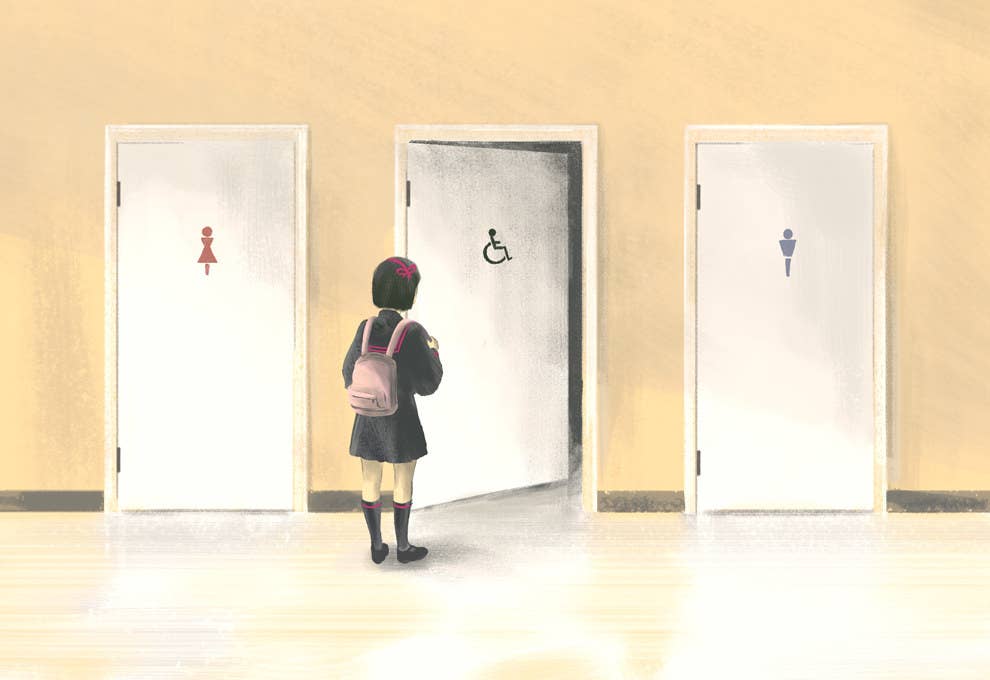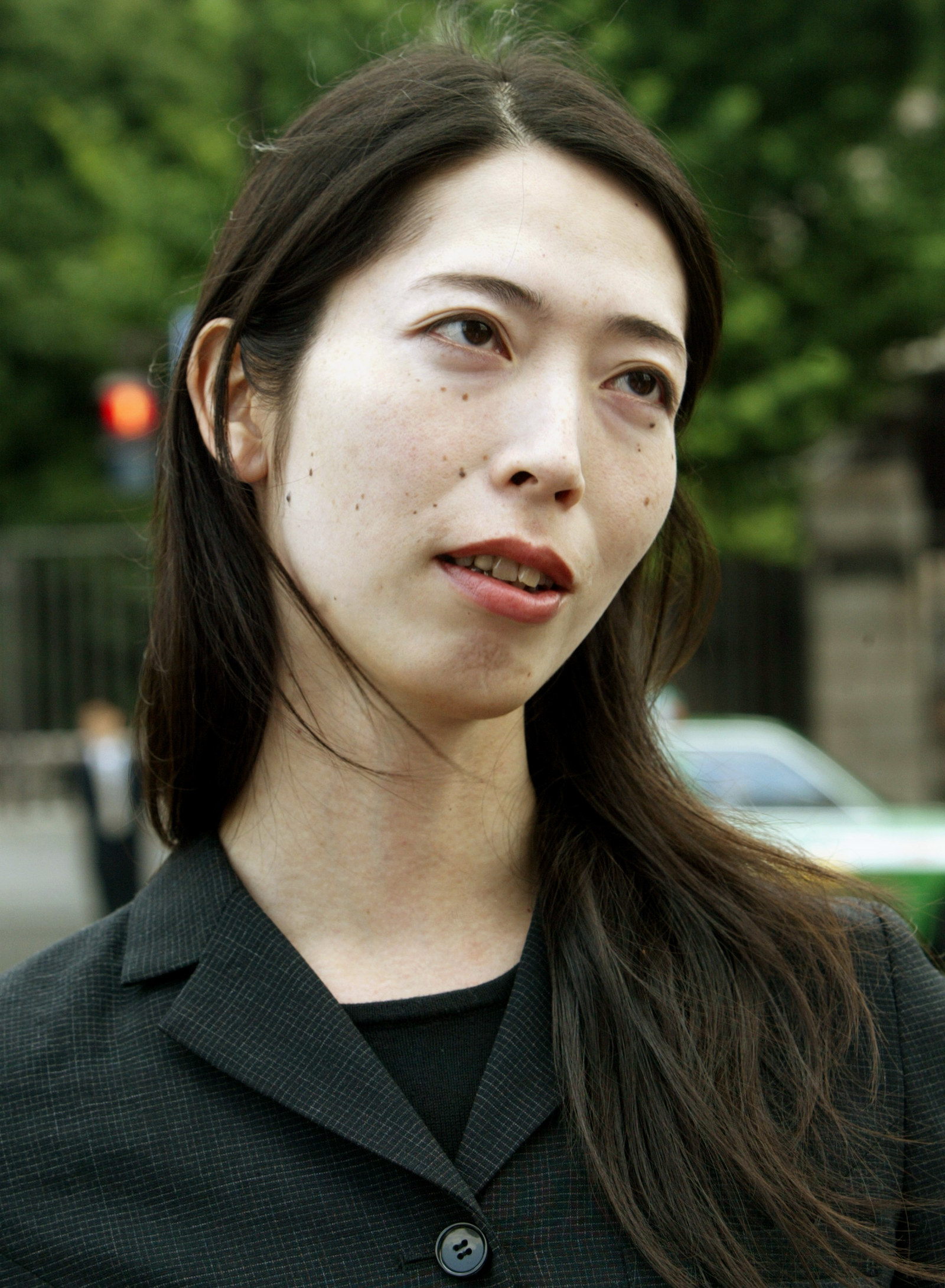
OSAKA, Japan — When the principal at a middle school in Osaka, a few hours west of Tokyo, insisted one of his new students do gym classes with the boys, the child's mother turned to the only person who could help: Dr. Jun Koh.
It was the spring of 2014, and the student was entering junior high at her new school. The problem posed by the gym classes was just the latest in a series of transitions she had been forced to navigate as she grappled with her identity — and it wasn’t the first time her mother had called on Koh for help.
Back in first grade, when the Osaka student began insisting on wearing skirts, Koh was able to reassure her mother that there was nothing wrong with a boy wearing girls' clothes. Later, in the fifth grade, the student wrote a will after the teasing she faced in the boys' locker room left her contemplating suicide. So they turned to Koh again, and he helped get the school comfortable with the idea of the student living as a girl full-time. Koh was even the one to explain to the parents of her classmates why she’d be sleeping in the girls' room on the sixth-grade class trip. (The student’s family requested her name not be used to protect her privacy.)
A rumpled, soft-spoken psychiatrist at Osaka Medical College, Dr. Koh has counseled more than 2,000 gender-nonconforming people in Japan. On this occasion, he found the school principal was adamant — the only way for the student to get out of the boys' gym class was if she had some kind of medical excuse. Boys and girls are graded separately because they have different physical advantages, he argued, and he would have to get sign off from the board of education to waive the rules.
So Koh gave her a diagnosis: gender identity disorder (GID), which is defined as “a desire to live and be accepted as a member of the opposite sex.” It is listed in the World Health Organization’s catalogue of ailments used by doctors all around the world, the International Classification of Diseases (ICD), which has 22 chapters covering everything from cholera to blindness to the loss of limbs. GID can be found in the chapter “Mental Health and Behavioural Disorders,” alongside conditions ranging from “profound mental retardation” to schizophrenia.
“Simply, if a boy wants to wear a skirt, he should wear a skirt.”
The diagnosis solved the Osaka student’s immediate problem: She would be allowed to play tennis with the girls. (“She’s terrible, but she’s so cute,” one of her mentors gushed.) And, as if accommodating a physical disability, the school renovated a bathroom intended for her private use — though she now isn’t allowed to access it for periods of the day when it’s reserved for a disabled classmate.
Koh gave the Osaka student the diagnosis — even though he doesn’t agree with it. Koh, who began his career specializing in schizophrenia, has become one of the few doctors in Japan who works with transgender children. There is an irony here, because Koh doesn’t believe these children need doctors.
“If the child expresses this gender identity, then let them be — they do not require diagnosis,” he told BuzzFeed News. “Simply, if a boy wants to wear a skirt, he should wear a skirt; if a boy wants to go to the girls’ bathroom, the boy should be able to use the girls’ bathroom. But in order for a boy to use the girls’ bathroom, the other girls have to accept [the child] in the girls’ bathroom. That’s all there is to it — giving a diagnosis won’t solve that problem.”
But he knows how the system works. He dispenses the diagnosis because in Japan, the doctor’s office has been the first stop for a transgender person seeking their basic rights, from changing legal documents to protection from discrimination. The role of the diagnosis is so fundamental that Japan’s 2003 law allowing people to change their legal gender is called the Law Concerning Special Cases in Handling Gender for People With Gender Identity Disorder, more commonly known as the Gender Identity Disorder Law.

Outside Japan, transgender activists have been engaged in a long fight to kill the term “gender identity disorder” and retake control over their lives from the doctors who diagnose it. This movement is poised for a major victory: A draft of the new edition of the ICD erases the term "gender identity disorder." When the WHO adopts the new edition in 2018, transgender people will no longer be branded as mentally ill.
But there is little appetite for this fight in Japan, where doctors have been responsible for transforming transgender people from eccentrics on the margins of society to fully fledged citizens.
Even leading transgender rights activists in Japan want the doctors to stay in control, fearing that if individuals are given the power to define their own gender, the entire system will collapse.
The fight over GID is part of a much more fundamental debate: Are trans people normal and capable of making their own decisions about how they live their lives, or does gender identity need to be regulated by authorities?
Supporters of reforming the ICD say they want to “depathologize” being trans — to end the perception that they have a disorder that requires a doctor’s management. Trans people, they believe, should have control over whether to access care like hormones or surgery and what gender markers their legal documents bear, and have those decisions respected.
The power of depathologization is clear from the history of the gay rights movement. The case that gays and lesbians deserve acceptance and rights has been built on the argument that they are normal: that they can’t and don’t need to change, that they don’t have a condition that can infect children, and that they have the character to serve in the military or hold other sensitive jobs.
Gay rights activists won that battle in US medical institutions in the 1970s, though it took 20 years for the WHO to follow suit. The WHO is playing catch up again; the American Psychiatric Association voted to reject the term GID in 2012.
The draft of the new ICD offers a new term, “gender incongruence,” emphasizing that a patient might need treatment for the ways their body does not match their sense of self — rather than defining the patient as disordered because their sense of self doesn’t match their body. This is partly to ensure that transgender people can still access therapies like hormones or surgery if they choose them. But nowhere in the new definition is the word “disorder.” Instead, the new ICD takes the concept out of the chapter on mental illness and puts it in a brand-new chapter devoted to “Conditions Related to Sexual Health.”
“To freely pick and choose without a medical condition — that’s not right.”
If the WHO adopts the draft as proposed, Japan’s medical community may have little choice but to follow suit, said Hiroshi Hase, now Japan’s cabinet minister responsible for science and education and a committee chair when the legislature adopted the GID law. The country’s medical system is required to follow the diagnoses laid out in the ICD.
“We will need to accordingly reclassify with the new concept that this is not a disorder,” Hase said in an interview with BuzzFeed News. "Because that’s the law."
But he said Japan was unlikely to follow the lead of the growing number of countries in South America and Europe that have introduced gender identity laws that reflect the spirit of these medical reforms. Known as “self-declaration” or “self-determination” laws, they allow you to change your gender simply by filing a declaration with a government agency — with no rules requiring sterilization or any other medical procedures, nor any doctors or bureaucrats demanding you “prove” your gender.
Doctors would likely always have a role in the process, Hase said, and Japan was far from ready for a radical rethinking of its gender identity law.
“We continue to explain to Japanese people who don’t have the understanding [of transgender people]: ‘These people aren’t like this because they chose to be — it’s not a fetish. They are only asking to be treated with the basic necessities to live their life,'” Hase said. “However, this requires changes including legal status and physical appearance, including genitalia, and hormone treatments and such. So naturally this would require medical assessment, and not just by one doctor but by several doctors.”
Even influential activists in Japan don’t want to be part of the global push to erase GID.
“I reject the notion of self-selection of gender,” said Ran Yamamoto, head of the organization gid.jp, which claims around 1,500 members, making it the largest organization of its kind in Japan. (Yamamoto rejects the term "transgender" and considers herself a “woman with GID.”)
“There is a reason why there is a separation between man and woman … I don’t know if God chose that or nature chose that,” she said. People with GID whose “disability compels them to change” their gender have a right to demand access to public toilets and other accommodations, she said, but for those “who do not have as much of a need, then gender should not be blurred.”
“To freely pick and choose without a medical condition — that’s not right," she said.
The story of why Japan’s transgender community stands so far apart from much of the global movement dates back to 1965, when police raided a bar in Tokyo’s Akasaka district and arrested 10 women on charges of prostitution, according to transgender historian Junko Mitsuhashi.
Three of these women were male on paper, which meant they couldn’t be prosecuted for selling sex — under Japan’s prostitution law only women could be charged for the offense. So the police went after the doctor who removed their male genitals, Dr. Masao Aoki.
Aoki wasn’t sentenced until 1969, perhaps because it wasn’t immediately clear what law he had broken by performing the operations. The prosecution ultimately charged Aoki with violating a law created early in World War II that relied on the same scientific ideas that informed the race laws of Japan’s ally, Nazi Germany: the National Eugenics Law of 1940. The Japanese law included a provision that made it a crime to sterilize any healthy person “without cause.”
A judge sentenced Aoki to two years in prison and a fine of 400,000 yen — a ruling that effectively banned sex reassignment surgery in Japan for the next three decades.
That might not have changed if doctors hadn’t miraculously saved the penis of a truck driver after it was badly mangled in a traffic accident in the mid-1980s.
“These people aren’t like this because they chose to be — it’s not a fetish.”
A surgeon from a medical school outside Tokyo, Dr. Takao Harashina, was brought in to reconstruct the driver’s genitals. The surgery was spectacularly successful, and the operation made headlines in 1992 after the patient managed to father children.
Those news reports caught the eye of a 25-year-old trans man who came to be known by the pseudonym Kei’ichi Nakahara. He called Harashina’s clinic, hoping the doctor could construct a penis for him. When other trans people followed suit, Harashina decided to challenge the ban on sex reassignment with a petition to Saitama University’s ethics committee.
It took two years for the ethics committee to reach a decision; in 1996 it declared that “an illness named gender identity disorder exists,” ending the freeze on sex reassignment almost overnight. Shortly afterwards, Japan’s Society of Psychiatry and Neurology adopted a protocol for diagnosing and treating GID, and the Ministry of Health certified that doctors would not face prosecution.
On May 1, 1998, Kei’ichi Nakahara became the first person to have sex reassignment in Japan in more than 30 years, and hundreds of others would soon follow.
Before GID, the terms available to describe trans people were all derogatory or tied to performance: “okama” — which translates roughly as "faggot" — or “Mr. Lady.” One of the most popular was "nyuhafu," the Japanese contraction of the English words “new half” and a play on “hafu,” children with mixed Japanese and white parents. Legend has it that the term traces back to a quip by an entertainer, “I’m half man and woman, so I’m a new half.”
Trans women were always quite visible in postwar Japan. Historian Mark McLelland writes that a group of transgender performers from France became celebrities in the early 1960s during a tour in Tokyo, clubs known as “show bars” sprung up in their wake featuring drag and trans performers — some who’d had sex reassignment abroad — appeared on television and magazines. The term "nyuhafu" became mainstream in coverage of Matsubara Rumiko, a winner of a Tokyo beauty competition in 1981 who became a celebrity when it was revealed that she was trans, releasing an album of songs called Nyuhafu and posing semi-nude in men’s magazines.
But visibility didn’t translate to acceptance in normal life — quite the opposite. It was fine for trans people to appear on television or in magazines, but it seemed impossible to ask for space in everyday life as long as cross-dressing seemed like an individualistic eccentricity.

“The opinion was … it’s still a personal preference — it’s a choice,” said Aya Kamikawa, who became Japan’s first out trans elected official when she won a seat on the municipal council of Tokyo’s Setagaya Ward in 2003. The attitude among the general public, Kamikawa said, was that “it’s so laughable that these people are demanding a right to have their personal preference respected.”
But there was no name for those living outside the world of entertainment or red light districts. Before GID was introduced, Kamikawa said, “I didn’t know what I was.”
The arrival of GID transformed her life. She was diagnosed in 1998, became an activist, and launched her political career in 2003 to help promote legislation to allow for people to change their legal gender. Three months after she was elected, the Japanese legislature unanimously adopted the Gender Identity Disorder Law.
The doctors had done what trans people never managed to do on their own: succeeded in convincing authorities and persuading everyday citizens that trans people deserved a place in everyday life. They had a medical condition that couldn’t be helped.
While calling something a “disorder” can make someone embarrassed or ashamed in many parts of the world, in Japan it can do the opposite: It makes behavior acceptable that would be shameful if seen as a personal eccentricity, said Junko Mitsuhashi, the historian.
GID was part of a pattern of pathologization in Japan — in the early 2000s, officials also gave a name to teenagers and young adults who were withdrawing from school and becoming hermits in their room: "hikikomori." The Ministry of Health first defined the term in 2003, leading to a flood of coverage of the phenomenon; by 2010, the country was estimated to be home to 700,000 people with the condition and there were NGOs dedicated to helping them out of isolation.
“Anything that is kind of deviating from what is considered the general flow of society can be diagnosed as something, [like] children who don’t want to go to school... If they put a medical name to the symptom, people will feel relieved,” Mitsuhashi said. “What really pushed the conviction to allow [the GID Law] to pass was the argument that this was an illness, a medical symptom.”
But not everyone was happy with the pathologization push. Mitsuhashi was one of a small group of trans activists who warned that it had a dark side.
“One senses that the logic is that ... an illness must be cured, and it is medicine’s role to bring these people to a normal, or ‘healthy’ state of alignment through treatment,” she wrote in the December 2003 issue of a magazine called Situation. “Such a thought could be expected from ignorant and close-minded doctors who believe they are elites within society ... After all, until those neuropsychiatrists introduced the concept of gender identity disorder in the early '90s, they were the ones who planted the roots of social prejudice and oppression by labeling transgenderism and transgender people as ‘perverts,’ ‘sexual deviants,’ ‘paraphiles,’ or ‘sexual anomalies.’”
It also meant leaving Japan’s rigid gender divide intact and in the hands of the largely male medical establishment, said Tomato Hatakeno, a trans activist who spent a decade as a sex worker and launched a Japan trans news site in 1996.
“People from the nyuhafu era … we were queer presences,” Hatakeno said. "And with the GID model coming out, these people were no longer queer … [living] stealthily so your queerness doesn’t show through." People who didn’t want surgery, or couldn’t afford it, or didn’t want to get on the track of full medical transition, “fell through the cracks” in a system where doctors seemed largely in control of their patients' lives.
In much of the rest of the world, transgender activists are fighting to take the power to define who they are away from authorities. In Japan, the transgender movement is more comfortable with authority — after all, it made them normal and gave them their rights.
But a new generation is trying to claim new control over how their gender is defined — they call themselves x-gender, and they are increasingly visible online.
One called Tsukasa from Kanagawa Prefecture southeast of Tokyo writes a blog under the name Hedwig, taking her name from the show Hedwig and the Angry Inch. Now in their late thirties, Tsukasa spent their life feeling out of place as a girl but also never felt a connection with people who wanted to have surgery to become a man, though they’d have her breasts removed if their husband would tolerate it, they said.
Hedwig is the parent of five-year-old fraternal twins, and the child they were raising as a boy, declared herself a girl at about three years old. Hedwig remembers the girl, who they call Makoto on their blog, saying: “I wish I didn’t have this bit, but if I cut it off, it’s going to hurt, right?”
Hedwig told her what it meant to be transgender, not to have GID.
“Treating it like an illness and to pathologize it — it just didn’t feel right,” they said. “I said, there are people whose gender does not match the gender that was given to them at birth. I said there’s nothing wrong with it, there's nothing weird — it’s natural.”
But Hedwig took Makoto to see a doctor anyway — the head of the Japanese Society of Gender Identity Disorder — to get a diagnosis when her daughter started going to kindergarten as a girl.
“Technically we needed it,” Hedwig said.

And as much as he wishes it would go away, Dr. Koh is working to further institutionalize the diagnosis. He’s chairing a committee of the Japanese Society of Gender Identity Disorder to create a certificate for doctors who specialize in the treatment of GID.
“I hate it,” Koh said, “but there’s also what goes on behind the screen.” Japan’s health care system will only pay for therapies if dispensed by certified specialists for treatments, and now Japanese transgender people must pay the full cost of surgeries or hormone treatments.
“Society should change into one where people can acknowledge their own gender and be accepted,” Koh said. He supports a proposal that would go even further than the new ICD draft and do away with any diagnosis for children, since there’s nothing a trans child needs from a doctor before reaching puberty — they’re too young for either hormones or surgery.
“Logically, it’s the right step for the WHO to remove that section,” Koh said. But, “I do what I can from my position … I don’t work only with logic — I see the individual and think only about what can be done to live the life they want.”


